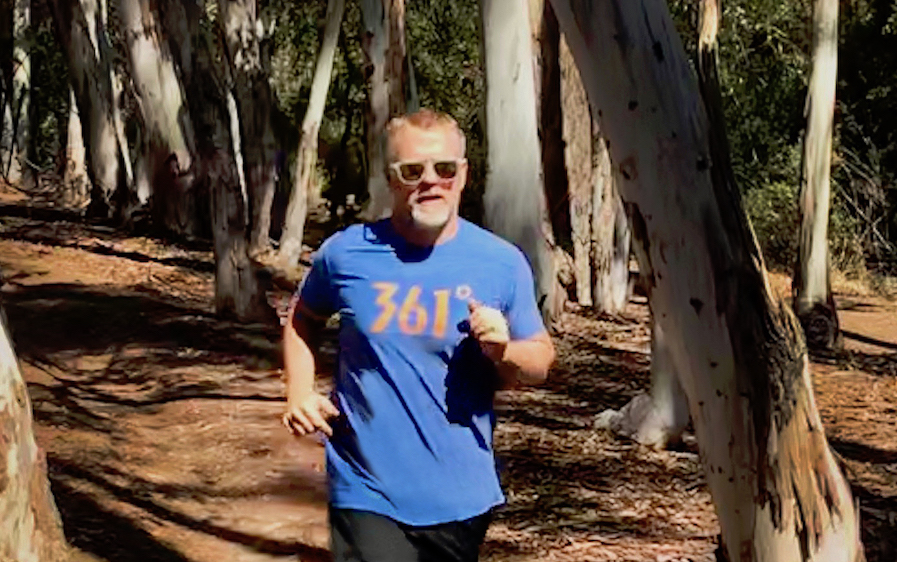By Eric Smith
Three years after 361 Degrees’ running shoes first rolled off assembly lines for North American distribution, the company is clearly hitting its stride.
The first half of 2018, in particular, has seen rapid acceleration thanks to new accounts, sales improvement across all channels and third-generation products, according to the company’s president, Jim Monahan.
“We are in a growth mode,” Monahan told SGB. “In the last eight months, we’ve added more doors than we’ve ever added as a company.”
Monahan, the former vice president of footwear for Asics America Corp. who took over 361 Degrees USA when the company launched in 2014, spoke with SGB at last week’s Fleet Feet National Franchise Conference in Minneapolis, MN, where he and some of his crew were exhibiting the company’s latest products and working to get their shoes into more stores.
361 Degrees USA is an Irvine, CA-based subsidiary of Chinese-based footwear and apparel manufacturing giant 361 Degrees International Ltd. The U.S.-based division is now gaining steam not only because of products featuring the company’s patented technology like Quikfoam, but also thanks to a marketing campaign befitting a new entrant in the highly competitive footwear space.
The company’s tagline line of “One Degree Beyond” is aimed to differentiate 361 Degrees’ product offerings from competitors. And the “Not Trending” campaign is designed to let customers and channel partners alike know they shouldn’t base their opinions of 361 Degrees’ products on how much love they get on social media.
“As a young brand we need to be a little disruptive,” Monahan said. “We want to have a dialogue with the customer. With ‘Not Trending,’ we’re saying, ‘Hey, you may not have heard of us. We’re not the latest. Other brands may have more likes on their Instagram page or Facebook page than we do. But this is who we are today. And if you’re looking for something new, try it and I bet you will like it.’”
Monahan is also focused squarely on how data and analytics can complement superior product offerings and smart marketing efforts, something he said he routinely discusses with retailers in an effort to grow the top line for everyone—thereby giving new meaning to the term “running partners.”
Here is the rest of what Monahan shared with SGB about what’s happening with the company as 361 Degrees moves from a startup (albeit one with a large international parent company) to a player that’s found a comfortable pace and is working to close the gap on competitors.
How’s business for 361 Degrees USA coming off your third year? Things continually grow. We’re doubling our business each year—obviously off a small base—but our primary goal is to make sure we set our distribution right. There’s business and then there’s healthy business. The first year was just getting out in front of accounts, getting some doors open. Our portfolio of accounts is probably 30 percent different today than it was when we first opened our doors. As the brand grows, as we improve our product collections and as we’re doing more marketing, we’re attracting more of what I call quality doors. That’s really a priority for us. It continues to evolve and continues to get stronger.
Where is 361 Degrees differentiating? We’re differentiating in that we’re new. It’s a new conversation for the retailers to have. We’re differentiating in our technology. Our Quikfoam technology offers a unique proposition for the end user. We’re differentiating on the business side. I talk to all our accounts about how we want to be partners in profitability, because in our minds it goes beyond just the product side of it. The old saying of “product is king”? That’s true, but the brands that are going to win today are going to spend as much time talking about business and how to increase certain metrics more so than those that are spending time talking about product. The playing field is pretty level today. There’s a lot of great product out there. First, the consumer needs to gravitate toward that product, but then secondly, the retailers that are carrying that product, they need to know they have a good partner; they need to know it’s easy to do business with that partner and that, from a profit standpoint, they can change that metric. Perhaps they don’t have an e-commerce platform, so their in-store transactions might be down. We’re differentiating ourselves in a way that says, “Let us put a little bit more money in your cash register for each and every transaction.” There’s a big part of our story that’s related to the business metrics.
It sounds like you’re using a lot of data and analytics to help yourselves and your channel partners grow. Is that a big component of this? And are you using business intelligence (BI) to make better decisions? We’re not as robust on the BI side as I’d like to be right now, but it’s certainly an area where we’re moving towards. That’s all part of the conversation. Let us dialogue together; let us be a part of your sales so we can understand and work together. Because it’s really about inventory turns. If we can help provide solutions in that regard, then we feel we’re a great partner.
Is that message being received? It is for the accounts that we’re working with. The challenge in today’s marketplace is getting retailers to think a little bit differently about, “Hey, I need a new brand.” What’s been nice about going into 2018 is I think there a renewed sense of optimism. Sales seem to be better to stores, and the stores are healthier. It’s really the first year that we’re seeing more accounts saying, “Let’s sit down and have a conversation about your product and about the business side. Let me hear the full package of what you guys have to offer.” We’re starting to see some expansion. We’re starting to see accounts more willing to add additional brands. So, is the message being received? Yes. Would I like it to be received quicker? Also, yes.
What is 361 Degrees USA’s channel strategy? Where are you seeing the most success and, since we’re here at Fleet Feet, how is Run Specialty performing, and is that a strategic channel for you? Absolutely. That’s my background. It’s the background of our team. It’s still the pinnacle of the business. That’s absolutely where we want to put our stake in the ground. We want to continue to support the channel. Today, we sit in about 250 doors, which is just shy of about 200 accounts. We obviously want to grow that penetration rate in Run Specialty, so there’s a lot more for us to do there. There are a lot of positive signs there. And I still believe that a big part of the obligation of the Run Specialty channel is to make sure that the product assortments are fresh, and when consumers are coming through the doors, there’s new product on the wall.
The product is at the heart of a running footwear company, but can you also differentiate on the messaging and the marketing and the story that you have? Is that a way to distinguish yourself? We believe our messages is a big part of that. When you look at our product, I like to say our “canvas” is not drastically different. If you look at a Hoka One One or an Altra, the canvas is a little bit different than what you would expect from your traditional brand. Our canvas is a little bit more traditional, but our content—what I like to call the cake mix—is different. Everybody bakes a cake. But really what are the ingredients, what are some of the finer ingredients? That’s an important part of what we do. The messaging is important. We need to be fun, we need to be new, we need to be fresh.
On that note, what is new and noteworthy? Our Strata 3 is in its third generation. If you look at the history of the industry, a lot of times it’s that third model that really gets it right. The first year, you get it to market and keep your fingers crossed. The second year, you fine tune. And the third year, it’s normally off to the races. We are focusing on the Strata 3 and also around Morph Fit. It’s a dynamic, top-down fitting system. Most of the fit systems that are in the industry today originate from the bottom and mid-sole up and don’t allow for a real customized fit. This allows us to customize the fit from the top down, depending upon foot shape. Everybody’s focusing a lot on foams and insoles, but we believe there’s a lot that can be improved on with fit. Comfort is still one of the major reasons why people buy shoes. Comfort is still one of the leading factors in preventing injury. So our goal is to continue to refine and define fit.
Sounds like you’re bullish on the company’s future, as well as the industry’s future? I am. People are going to always want to stay fit. This is the only industry I know. I got out of college and into this industry, so I love it. I’m bullish on our future as well. There are enough strong indicators to that say consumers are gravitating toward our product, and at the end of the day they’re who determine whether a brand wins or loses. We need to get more product in store, but the consumer needs to buy it, like it and love it. We’re focused on breaking through the clutter—with our product, but also with our marketing.
Photos courtesy 361 Degrees
[author] [author_image timthumb=’on’]https://s.gravatar.com/avatar/dec6c8d990a5a173d9ae43e334e44145?s=80[/author_image] [author_info]Eric Smith is Senior Business Editor at SGB Media. Reach him at eric@sgbonline.com or 303-578-7008. Follow on Twitter or connect on LinkedIn.[/author_info] [/author]

















